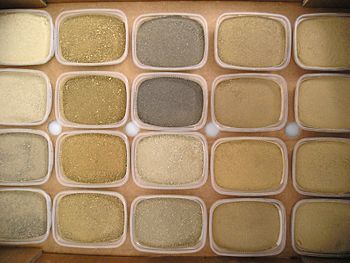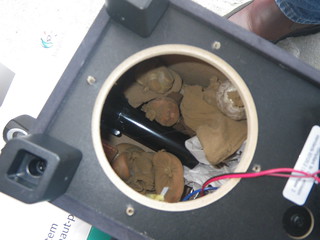| Forest lake in summer (Photo credit: Axel-D) |
* Soil
* Wood
* Pollen grains
* Animal hair (blog link)
* Animals
* Insects (blog link)
* Protists (single celled organisms found in water)
SOIL
| Soil types (Photo credit: Wikipedia) |
* The shoes of a suspect (blog article: footwear evidence)
* Show soil from where a victim was left.
Soil is made up of
* Inorganic - percentages of the combinations and make up of the
soil differs from region to region so can help pinpoint an area
`rocks
`minerals (naturally occurring crystals)
* Organic
`humus
`decaying animal and bug matter
`scat (dung)
* Man made
`glass
`oil/gas
`paint
`Brick/asphalt
Who will test this information in the crime lab?
* Chemists
* Geologists
Video Quick Study (4:24) talks about using soil in Manson murder
Video Quick Study (9:11) soil samples might be analysed for poison
and environmental crimes.
Soils vary -
1. Color
Munsell System - describes the color of the soil
* Chroma (purity of the color)
* Hue - the color
* Value - amount of white or black
2. Texture - like clay
3. Particle size - measured through a graduated sieve.
4. Chemistry
POLLEN AND PROTISTS
Under a microscope investigators look for samples of pollen, protists| Scanning electron micrograph of Ipomoea purpurea pollen. (Photo credit: Wikipedia) |
Palynology - the study of spores and pollen.
Pollen and spores make good forensic evidence because -
* They don't degrade easily
* Distinctive to a locality
* Help clue investigator to
determine if the body was
moved from one location
to another
Protists -
* Reproduce at certain times of the year - so they could narrow
time frames.
Ex. algae blooms in water
* If the body was in water or is suspected to have been in water,
protists might be able to lead them to a specific location.
SEM - scanning electron microscope
Video Quick Study (5:45) Pollen under the microscope and
identification
Video Quick Study (1:50) Forensic botanist testifies at Casey
Anthony trial
Video Quick Study (1:09) Forensic botany
WOOD
How is identifying wood helpful in an investigation?| English: Pile of woods. (Photo credit: Wikipedia) |
* Clues that might help
identify a piece of wood
`cut marks
`nail holes
`unique species
`Species coming from a
distinct region
* Lindbergh baby abduction
used a homemade ladder
was left at the scene. The
wood expert looked at the tool marks used to
make the ladder and the different types of wood that were
included in the construction
Video Quick Study (3:28) Lindbergh wood expert
ANIMALS
| English: Black bear (Photo credit: Wikipedia) |
* Perhaps the investigator
is trying to determine
which animal attacked a
human.
* Diseased animals might
cause attacks (such
as rabies)
* Bite marks are examined
by forensic odontologists
(dentists)
Video Quick Study (2:25) forensic odontologist at work
* Animals at large are tracked using the same methods
as with humans (blog article: footwear)
* If the investigator suspects the animal that attacked/ate someone
was found the investigators will examine the animal's stomach
contents.
| (Photo credit: Wikipedia) |
An animal might be the victim
* Abuse
* Poaching
Video Quick Study (2:16) Wildlife forensic biologist
* Poisoning/baiting - tested by forensic chemists
* Hunting outside of the proper season or with illegal methods
* Illegal trade in protected wildlife is the third largest grouping of
criminal activity following drugs and guns.
` Worth billions a year.
` Endangered Animals and Plants - Over 30,000 plant and animal
species garner special protection.
` Can be found in the form of meats, fish, or fish roe available for
consumption. DNA would be used to try to determine the
number of animals involved by finding out how many unique
DNA patterns are present.
` Clothing might be made from the body of a protected species.
` Ground into medicines - investigated by forensic chemists
* Wildlife is protected in the United States by the Department of
Homeland Security - Border Protection Division
Information Link
`Protect endangered species
`Protect our eco-systems from the introduction of invasive
species.
| Snakes in a speaker 1 (Photo credit: USFWS/Southeast) |
Video Quick Study (2:14) new wildlife forensics lab to protect the wildlife
Video Quick Study (6:44) Being a Wildlife ranger - protecting the animals is incredibly dangerous. What great heroes and heroines to write into a plot line.
Video Quick Study (6:29) CSI for wildlife
*Inspectors might find animal hair that help link a suspect to a
crime scene (blog article: fur evidence)
* Snarge - the pulverized bird remains stuck to an airplane.
Samples of birds and birds pieces are kept at the Smithsonian in
Washington D.C. The feathers and bird remains found at the
scene or an airplane accident help to determine if the plane was
downed by birds.
Video Quick Study (13:22) Goes through the forensics of flight
1549 and bird strike forensics.
The Environment -
All of the same scene and evidence protocols have to be maintained (blog article: CSI 101)
| Dead fish up close (Photo credit: severinus) |
* EPA involvement
* Dead zones on land and in
water
* Strange Odors
* Dead wildlife
* Accidental or criminal
poisoning of the environment
`Heavy metals
`Insecticides
`Gas/oil
* Critical investigative work because these toxins enter the food
chain and effect our health.
Video Quick Study (2:13) Dan River coal ash - human water
supply, environmental impact.











